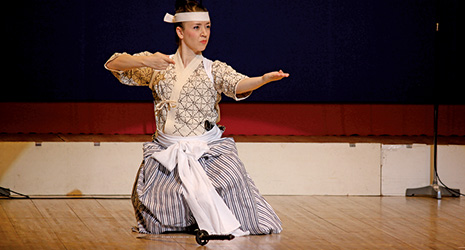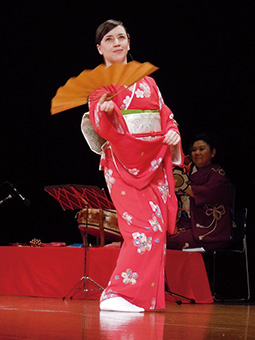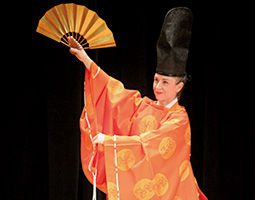Home > Highlighting JAPAN > Highlighting Japan November 2017 > My Way
Highlighting JAPAN


Moved by Minyo
Professional minyo performer Canadian Maud Archambault hopes to share Japan’s folk songs and dances with audiences around the world.
Japanese folk songs, or minyo, have long been handed down by common people all over Japan through rituals such as prayers and festivals, and at places of work related to agriculture, forestry and fishing. Of the groups working to spread and hand down minyo, the Japanese Folksong Professional Society is one that only accepts professional performers and dancers among its ranks. In 2014, Canadian-born Maud Archambault was registered as the society’s first foreign dance member.
Archambault describes the appeal of minyo. “Japanese folk songs come in various types: there are glamorous ones, spirited ones and even somewhat lonely ones, but strangely, whichever I listen to it lifts me up. Even on days when I’m physically or mentally drained, if I arrive at the rehearsal hall and we all perform as one, it never fails to cheer me up,” she says.
Archambault, who majored in psychology at the University of Montreal in Canada, first developed an interest in Japan after minoring in East-Asian Studies, and her desire to learn more about Japan led to her arrival in 2001. When she shared her desire to learn the shamisen, a Japanese three-string instrument, with a student at the English conversation school she was working at after coming to Japan, she was introduced to the Muramatsu Japanese Traditional Performing Arts Academy, a school in Warabi, Saitama Prefecture of which Archambault is still a member.
“I began learning minyo because I wanted to try something I could only experience in Japan while I was here. Before I knew it, it’s fifteen years later and I’m still involved with it,” Archambault recounts with a laugh.
According to the curriculum at the Academy, students take lessons across the four minyo subjects, namely singing, dancing, shamisen and taiko drums, for each song, in order to deepen their understanding of the song. Archambault has studied all of the other subjects in addition to the shamisen, and now says dancing is her favorite part. She quickly learned how to properly dress in traditional Japanese kimono, an essential element when dancing to minyo. While Archambault says she had difficulty learning how to vocalize the songs and their unique melodies, in 2011 she managed a win in the youth category at the Second Saitama Prefectural Convention of Folk Songs and Dance run by Japanese Folk Song & Dancing (Public Interest Incorporated) Foundation, and went on to perform at the National Convention of Folk Songs and Dance held at Ryogoku Kokugikan.
Archambault sang “Tsugaru-Tantobushi” at the convention. The song was originally sung to the beat of rice straw being slapped to soften it at straw work sites over the long snow-bound winter months when no farm work could be carried out in Akita Prefecture. The song then got modified by people from the Tsugaru district of Aomori Prefecture, which is next to Akita Prefecture. Today the song is accompanied with the tsugaru-jamisen (a type of shamisen), and is widely recognized as a popular minyo song.
Minyo’s origins lie in work songs hummed by workers in sync with the kinds of chores described above, and many of the songs continue to be sung all over Japan today. When Archambault learns a new minyo, she tries to visit the region where it originated to learn about the history and culture behind the song. When she visited Shizuoka Prefecture, which is famous as a tea-producing region, she experienced the task of picking tea leaves.
“I got a real sense of how the dance for the tea-picking song incorporates actual tea-picking actions,” explains Archambault.
Today, Archambault has such extensive knowledge of minyo that she gives explanations about the songs to Japanese.
“Since minyo depicts the traditional lifestyle of each region in the words of that region, it’s something I really want to preserve,” she says. “Once they learn the meaning behind these songs, I think people feel a greater affinity for the minyo sung around where they live.”
Archambault is currently working on performance and dance rehearsals three times a week and also giving performances at events in various locations. In particular, Archambault believes that in stage performances created together with her teacher from song selection to process, all the qualities to best convey the charm of minyo are assembled, and moving forward she hopes to focus her efforts in that area.
Archambault also wants to disseminate information about Japanese minyo around the world.
“Kabuki is well known overseas, but there are many other wonderful aspects to Japanese performing arts and culture, and I want to convey that minyo is one of them,” she says. “Instead of just performing song and dance, if you explain the historical background to a song and the meaning it captures, I think people from overseas will also be able to enjoy imagining what traditional Japanese life was like. That’s another reason why I want to keep on studying. But there are so many songs that it might take me a lifetime to learn them all.”
There are thought to be over 58,000 Japanese minyo still preserved to this day. As Archambault continues to sing and dance with an expanding repertoire, Japanese minyo will continue to lift spirits wherever she goes.
© 2009 Cabinet Office, Government of Japan








